Here’s a wee update on my current embroidery project, a white-on-white ecclesiastical piece. I’ve finished all the outlining on the design, and now I’m going to seed stitch certain parts of it.
On this piece, I’m using whipped backstitch to form the ridged outlines. I wanted a firm line with a little height to it, but I didn’t want to work an overcast or trailing outline around the whole design, because that would’ve taken ten forevers! So whipped backstitch was the choice, as it’s relatively quick to work and I do like the look of the lines created by the stitch.
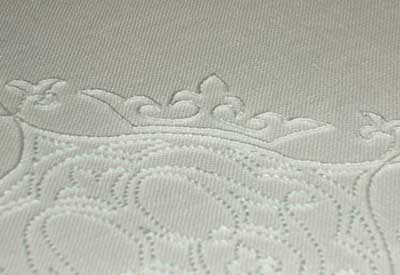
You can see above the difference between the backstitching and the whipped backstitch – the crown part of the design at the top of the photo has already been whipped, and the line is much smoother than the backstitch line. It’s funny – in these photos, which were taken under a bright light, I really like the look of the backstitch, too. Actually, I like to look at the contrast between the backstitched line and the smoother lines of the whipped backstitch.
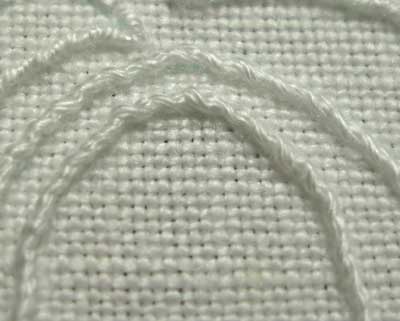
A couple little warbly problems presented themselves in the whole backstitch-whipping endeavor. Why does this happen? Pretty much, it’s because the working thread gets too twisted, and as it twists on itself, it stiffens as it wraps around the backstitches. The solution: drop your thread and let it untwist every so often. In fact, when whipping the stitch like this, depending on the direction you’re working in, the thread will often become twisted very quickly, so it’s a good idea to drop that needle and let it dangle from your work quite often, in order for the tread to untwist.
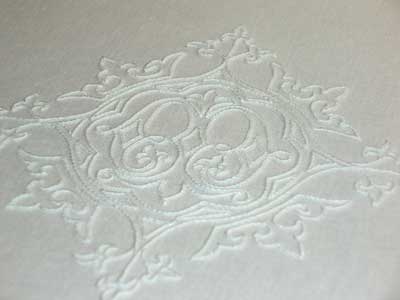
Overall, I like the design and the ridged line created by the stitch. My intention was to create a high enough line that it would cast a small shadow, making the design more visible from afar. I wasn’t sure how well that plan would work, but at least, with a ridged line rather than a flat outline, I know it will be somewhat more visible from afar.
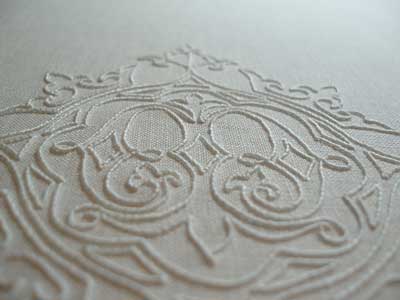
I tried photographing the piece at different angles in different light to see if I could get a decent shadow from the lines…
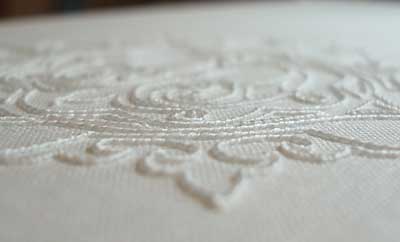
… but I’m no grand photographer, and I don’t always “get it,” when it comes to picture-taking!
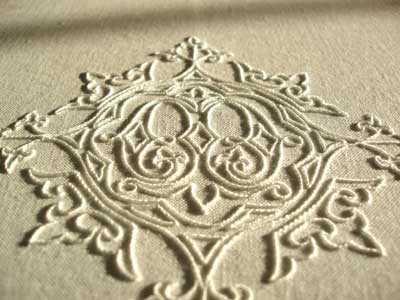
But then, just as I was closing up shop for the day, for the first time all day, the sun came out. It was slanting in the western window in my studio, right across my work, and I said, “Wow. Now there’s a shadow!”
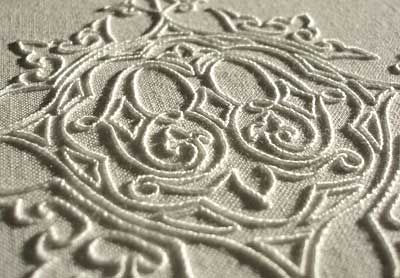
The linen doesn’t look as white here through the eye of the camera, I suppose. BUT … the relief created by the stitching is much more obvious.
Yes, I’m satisfied so far with this part of the stitching. It’s the look I wanted, anyway. Now, on to the seed stitching! I’m trying to optimistically think that I’ll be finished with all the stitching by this evening, and able to assemble the pall tomorrow and put a hand-tatted edge on it. Um. Well, there’s nothing wrong with optimism! I’ll let you know if it happens!







It is so white, so nice that I am thinking about doing something similar too. I guess, I'll find someone who will be glad with such a gift. And your pall is wonderful as always. I am waiting the finish…
It is so white, so nice that I am thinking about doing something similar too. I guess, I'll find someone who will be glad with such a gift. And your pall is wonderful as always. I am waiting the finish…
Absolutely stunning! Wow!
Mary –
Your work is beautiful!
What kind of linen are you using and where do you purchase it?
Thanks –
Susan
Wow. I don't ever dare have anything that white around here; it'll be grubby in seconds!
Looks AWESOME!
Hi, Susan – I'm using Alba Maxima by Legacy. Originally, I was using ecclesiastical by Legacy linen when I started the project, but the thread and the fabric didn't really work together, so I went to something a little heavier. It's not as bright a white, but still, it's white. I like it for working with the heavier coton a broder. Ecclesiastical linen by Legacy is great for finer threads, though. I sort of wish I had gone with the ecclesiastical with a very fine thread, but I'm overall pretty pleased with this so far…
You can find Alba Maxima at any online needlework shop that carries Legacy linen, which I believe is imported by Access Commodities, so probably anywhere that carries Access Commodities supplies would be able to order linen from Legacy linen.
Hope that helps!
MC
that's absolutely gorgeous! I'm definitely going to try some whipped backstitch pretty soon. Love those last few shots.
Yes you said it. Those last two shots are definately "Wow"!
Absolutely beautiful, I do love the whipped backstitch and the contract makes the whole design sing. Barb
Absolutely stunning. I am going to take a stab at this technique. I have been cheating so far. I whip machine stitches in a contrast colour on hems of children's dresses.
It's nice to find an object that can feed embroiderer's eyes and fulfill their hunger for beauty.
I love this piece and wonder how is it possible that something so fine can be created by a man 🙂
(I hope my level of English didn't prevent you from understanding of what I ment:-D )
Absolutely beautiful Mary!
really it's wonderfull. I'll try to do the same work this summer.!
Hi, Mary,
I am new to your site, but completely in love with it! I found this piece as I am looking to embroider monogrammed napkins. I really loved the white on white as well as the “shape” of your design. What letters did you use? Also do you have a PDF for the “frame”? Not sure what your piece was but it is gorgeous!! Would your linen/thread combo be appropriate for formal napkins or should I use a different kind? I would be extremely grateful for your guidance! 🙂
Regards,
Susana
Hi, Susana – I drew this design, using a combination of a monogram used for ecclesiastical embroidery and my own doodling. I’m afraid I don’t have a design available for this project. But the stitching concept can certainly be carried over to any monogram design, and the stitches are pretty simple – just a whipped backstitch and seed stitching. You’ll find instructions for both under “how to videos” in the main heading on the website. You can see the design with the seed stitching worked in, here: https://needlenthread.wpengine.com/2009/06/adding-texture-with-seed-stitch.html. If you’re looking for monogram alphabets, you might like this collection: https://needlenthread.wpengine.com/2016/07/16-favorite-monogram-alphabets-all-in-one-place.html Hope that helps!
Thank you so much, Mary! 🙂
I will try to recreate something similar then 😉 Also, regarding the linen and the cotton a broder… I saw what you responded to another reader and, since I am not familiar with the weight/feel of that brand, would you say that it could work for napkins or would it be too heavy? I cannot really tell from the pictures…
Thank you so much for the inspiring and beautiful work!
Susana
The thread is perfect for monogramming napkins and other household linens. You couldn’t really find a better thread out there for that purpose! 🙂